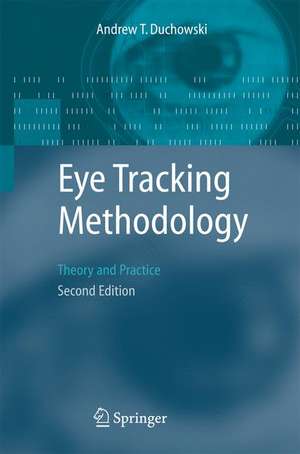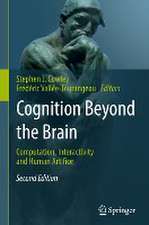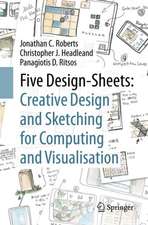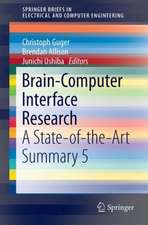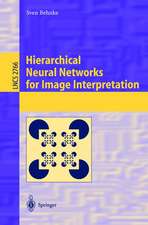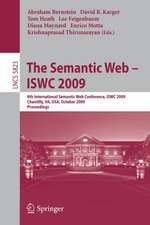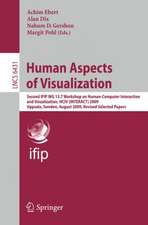Eye Tracking Methodology: Theory and Practice
Autor Andrew Duchowskien Limba Engleză Paperback – 14 aug 2007
Additional key features of the 2nd edition include: Technical description of new (state-of-the-art) eye tracking technology (new chapters 9, 10, and 11); a complete whole new Part describing experimental methodology including experimental design, empirical guidelines, and 5 case studies (new chapters 13, 14, and 15); survey material regarding recent research publications included within Part IV.
This second edition is a invaluable guide for practitioners responsible for developing or implementing an eye tracking system, as can also be used as a teaching text for relevant modules on advanced undergraduate and postgraduate courses.
Preț: 648.44 lei
Preț vechi: 810.55 lei
-20% Nou
Puncte Express: 973
Preț estimativ în valută:
124.09€ • 134.75$ • 104.24£
124.09€ • 134.75$ • 104.24£
Carte tipărită la comandă
Livrare economică 22 aprilie-06 mai
Preluare comenzi: 021 569.72.76
Specificații
ISBN-13: 9781846286087
ISBN-10: 1846286085
Pagini: 360
Ilustrații: XXVI, 334 p. 113 illus.
Dimensiuni: 155 x 235 x 27 mm
Greutate: 0.5 kg
Ediția:2nd ed. 2007
Editura: SPRINGER LONDON
Colecția Springer
Locul publicării:London, United Kingdom
ISBN-10: 1846286085
Pagini: 360
Ilustrații: XXVI, 334 p. 113 illus.
Dimensiuni: 155 x 235 x 27 mm
Greutate: 0.5 kg
Ediția:2nd ed. 2007
Editura: SPRINGER LONDON
Colecția Springer
Locul publicării:London, United Kingdom
Public țintă
Professional/practitionerCuprins
to the Human Visual System (HVS).- Visual Attention.- Neurological Substrate of the HVS.- Visual Psychophysics.- Taxonomy and Models of Eye Movements.- Eye Tracking Systems.- Eye Tracking Techniques.- Head-Mounted System Hardware Installation.- Head-Mounted System Software Development.- Head-Mounted System Calibration.- Table-Mounted System Hardware Installation.- Table-Mounted System Software Development.- Table-Mounted System Calibration.- Eye Movement Analysis.- Eye Tracking Methodology.- Experimental Design.- Suggested Empirical Guidelines.- Case Studies.- Eye Tracking Applications.- Diversity and Types of Eye Tracking Applications.- Neuroscience and Psychology.- Industrial Engineering and Human Factors.- Marketing/Advertising.- Computer Science.- Conclusion.
Recenzii
From the reviews:
"The book provides an in-depth overview of the science and applications behind eye-tracking. ... To its merit, the content for each chapter is supplemented with further readings sections, which will allow interested readers to delve deeper in one direction or another. The book is written in an easy-to-understand language. Given its breadth, it may be most appropriate for scientists and students starting in this field. ... Overall, I found it to be a solid book on a fascinating topic." (Stefan Robila, ACM Computing Reviews, October 2008)
From the reviews of the second edition:
"The four-part structure enables you to quickly locate material suited to your background and needs; additionally, each chapter concludes with a helpful summary and discussion of further resources. … the book does offer useful information for those interested in conducting eye tracking studies." (Eva R. Brumberger, Technical Communication, Vol. 55 (3), August, 2008)
"The book provides an in-depth overview of the science and applications behind eye-tracking. ... To its merit, the content for each chapter is supplemented with further readings sections, which will allow interested readers to delve deeper in one direction or another. The book is written in an easy-to-understand language. Given its breadth, it may be most appropriate for scientists and students starting in this field. ... Overall, I found it to be a solid book on a fascinating topic." (Stefan Robila, ACM Computing Reviews, October 2008)
From the reviews of the second edition:
"The four-part structure enables you to quickly locate material suited to your background and needs; additionally, each chapter concludes with a helpful summary and discussion of further resources. … the book does offer useful information for those interested in conducting eye tracking studies." (Eva R. Brumberger, Technical Communication, Vol. 55 (3), August, 2008)
Textul de pe ultima copertă
Despite the availability of cheap, fast, accurate and usable eye trackers, there is still little information available on how to develop, implement and use these systems. This second edition of Andrew Duchowski’s successful guide to these systems contains significant additional material on the topic and fills this gap in the market with this accessible and comprehensive introduction.
Opening with useful background information, including an introduction to the human visual system and key issues in visual perception and eye movement, the second part surveys eye-tracking devices and provides a detailed introduction to the technical requirements necessary for installing a system and developing an application program. The book focuses on video-based, corneal-reflection eye trackers – the most widely available and affordable type of system, before closing with a look at a number of interesting and challenging applications in human factors, collaborative systems, virtual reality, marketing and advertising.
Key features of this second edition include:
• Three new chapters providing technical descriptions of new (state-of-the-art) eye tracking technology
• A complete new Part describing experimental methodology including experimental design, empirical guidelines, together with 5 case studies
• Survey material regarding recent research publications included within Part IV
The second edition of Eye Tracking Methodology is an invaluable guide for practitioners responsible for developing or implementing an eye tracking system, and can also be used as a teaching text for relevant modules on advanced undergraduate and postgraduate courses.
‘One of the most comprehensive books on eye tracking ever written. A must-read for novices and experts alike.’
Roel Vertegaal, Human Media Lab, Queen’s University, Canada
‘… the first comprehensivetreatment of a critical methodological area, this book unites the field’s core theoretical underpinnings with real-world applications and practical know-how …’
Dario Salvucci, Drexel University, USA
Opening with useful background information, including an introduction to the human visual system and key issues in visual perception and eye movement, the second part surveys eye-tracking devices and provides a detailed introduction to the technical requirements necessary for installing a system and developing an application program. The book focuses on video-based, corneal-reflection eye trackers – the most widely available and affordable type of system, before closing with a look at a number of interesting and challenging applications in human factors, collaborative systems, virtual reality, marketing and advertising.
Key features of this second edition include:
• Three new chapters providing technical descriptions of new (state-of-the-art) eye tracking technology
• A complete new Part describing experimental methodology including experimental design, empirical guidelines, together with 5 case studies
• Survey material regarding recent research publications included within Part IV
The second edition of Eye Tracking Methodology is an invaluable guide for practitioners responsible for developing or implementing an eye tracking system, and can also be used as a teaching text for relevant modules on advanced undergraduate and postgraduate courses.
‘One of the most comprehensive books on eye tracking ever written. A must-read for novices and experts alike.’
Roel Vertegaal, Human Media Lab, Queen’s University, Canada
‘… the first comprehensivetreatment of a critical methodological area, this book unites the field’s core theoretical underpinnings with real-world applications and practical know-how …’
Dario Salvucci, Drexel University, USA
Caracteristici
Only book to provide detailed practical advice on how to set up, operate and develop an eye tracking system New sections of the book explain system installation, software development, and calibration Complete new section on experimental methodology included, providing guidance to readers on how to conduct their own eye tracking experiments - 3 case studies are presented as examples
